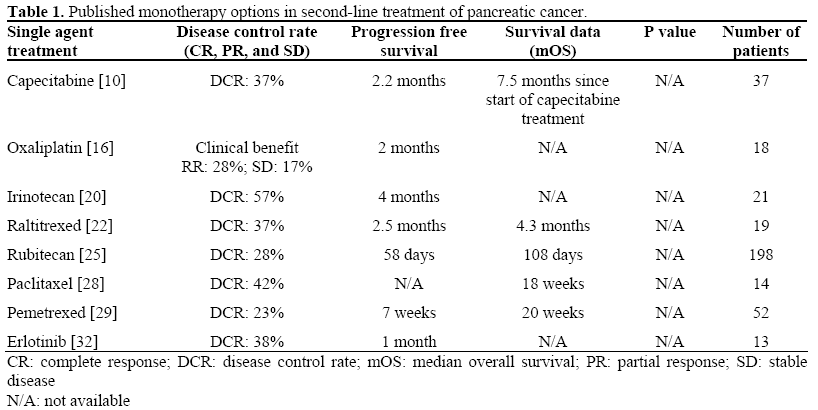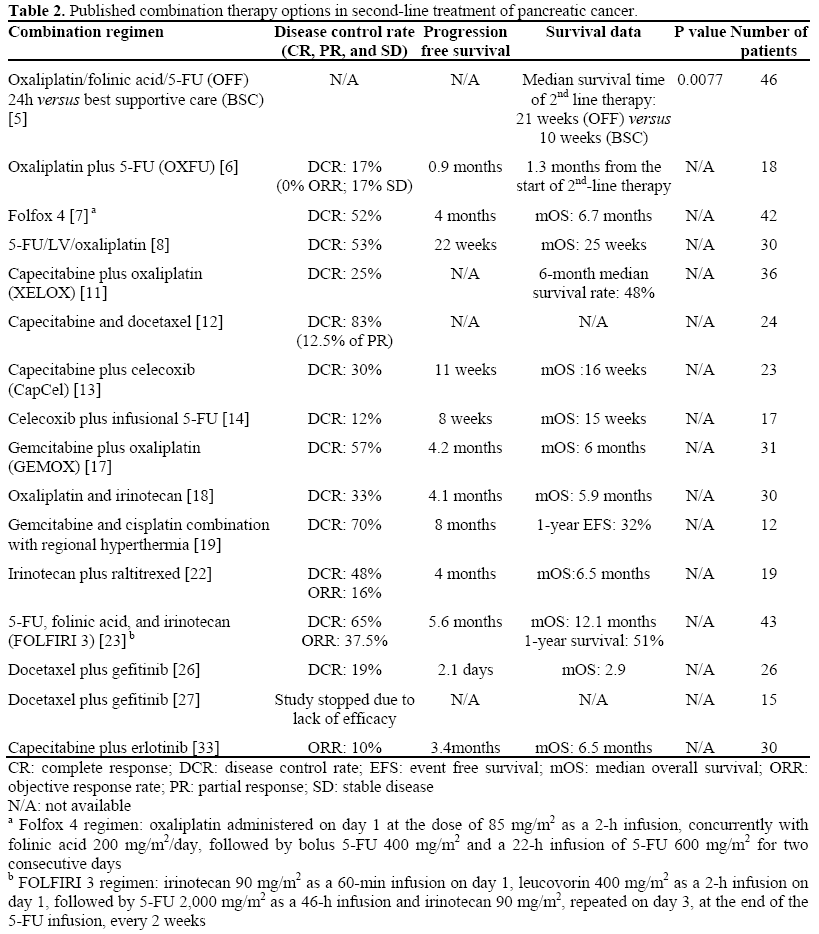- (2008) Volume 9, Issue 2
Soonmo Peter Kang, Muhammad Wasif Saif
Medical Oncology and Developmental Therapeutics Program, Yale University School of Medicine. New Haven, CT, USA
Received November 12th, 2007 - Accepted December 12th, 2007
Pancreatic Neoplasms; Salvage Therapy; Treatment Failure
ASCO: American Society of Clinical Oncology; LV: leucovorin
Since the birth of fluorouracil (5-FU) 50 years ago, we have made only incremental changes in clinical outcomes in pancreatic cancer. Gemcitabine remains to be the only standard of care in advanced pancreatic cancer since mid-1990s [1]. Numerous trials which enrolled thousands of patients failed to improve the outcome significantly beyond gemcitabine. At present time, data set in 2nd line setting is grossly limited. One reason is that most advanced pancreatic cancer patients who progress on their 1st line treatment are often poor candidates for clinical trials due to their worsening performance status. Lack of active agents seen in number of trials in 1st line is another limitation in advancing agents in 2nd line setting. The change of this rather dark landscape in 1st line setting is suggested by two recent large randomized phase III trials in advanced pancreatic cancer showing that addition of capecitabine or erlotinib to gemcitabine render superiority to single-agent gemcitabine [2, 3].
There is growing evidence supporting benefit of chemotherapy after gemcitabine failure in selected patients with good performance status (Tables 1 and 2) [4]. In order to establish a much needed effective 2nd line treatment options for advanced pancreatic cancer, we need cooperative efforts among institutions and community practices in enrolling gemcitabine refractory patients in clinical trials.


Fluoropyrimidine
Single agent 5-FU has shown benefit over best supportive care in number of clinical trials in advanced pancreatic cancer and has been the standard of care for approximately 40 years until mid 1990’s when gemcitabine emerged as the new standard [1]. Response rates with 5-FU alone with or without leucovorin (LV) in various infusional modes in 1st line settings have been modest. Currently, there is no data supporting the use of 5-FU/LV alone in gemcitabine refractory advanced pancreatic cancer patients.
Clinical trials including phase III randomized trial proving that patients with refractory advanced pancreatic cancer benefit from salvage chemotherapy with 5-FU based regimen [5, 6]. Various combinations of 5- FU/LV/oxaliplatin were tested in advanced pancreatic cancer patients after gemcitabine failure and have shown promising disease control rates. A chemotherapy protocol consisting of oxaliplatin, 5-FU, and folinic acid (Folfox 4; oxaliplatin administered on day 1 at the dose of 85 mg/m2 as a 2-h infusion, concurrently with folinic acid 200 mg/m2/day, followed by bolus 5-FU 400 mg/m2 and a 22-h infusion of 5-FU 600 mg/m2 for two consecutive days) appears to be the most active regimen of this combination resulting in 52% disease control rates and 4 months progression free survival (Tables 1 and 2) [7, 8].
Capecitabine is an oral fluoropyrimidine which was tested in 1st line setting with clinical benefit response rate of 24%, suggesting possible role of capecitabine as a salvage therapy after gemcitabine failure [9]. Capecitabine as monotherapy or in combination with oxaliplatin (XELOX) has shown encouraging disease control rates in gemcitabine refractory patients [10, 11]. Capecitabine and docetaxel combination is also an active 2nd line treatment option with 71% of patients maintaining stable disease for 2 or more cycles (Tables 1 and 2) [12].
Lately, a novel combination of capecitabine plus celecoxib resulted in modest activity in 2nd line setting of advanced pancreatic cancer [13]. Celecoxib was also combined with protracted intravenous 5-FU in gemcitabine refractory advanced pancreatic cancer patients and shown modest activity suggesting synergy between fluoropyrimidine and celecoxib [14]. S-1 is a fourth generation oral fluoropyrimidine with a potential activity in pancreatic cancer in second line setting and needs further investigation (Tables 1 and 2) [15].
Platinum
Single agent oxaliplatin rendered a clinical response in 28% of advanced pancreatic cancer who progressed on gemcitabine [16].
Oxaliplatin in combination with 5-FU and capecitabine is a reasonable 2nd line treatment option in advanced pancreatic cancer as described in above section. Gemcitabine plus oxaliplatin (GEMOX) showed activity in 2nd line setting after gemcitabine failure. GEMOX regimen showed approximately 57% disease control rates with median time to progression of 4 months in a study by Demols et al. [17]. Cantore et al. also reported 20% clinical response rates with duration of 7.2 months using a combination of oxaliplatin and irinotecan in gemcitabine refractory advanced pancreatic cancer patients [18]. Gemcitabine and cisplatin combination with regional hyperthermia was evaluated in advanced pancreatic cancer patients after gemcitabine failure. This regimen, at interim analysis which was presented in the 2006 American Society of Clinical Oncology (ASCO) meeting, showed a potential although only 12 patients were evaluated at the time [19].
Topoisomerase Inhibitors
Irinotecan monotherapy is active as a 2nd line treatment of gemcitabine refractory advanced pancreatic cancer patients. Fifty-seven percent of patients had disease control with median time to progression of 4 months [20]. Preclinical study suggesting that pemetrexed and irinotecan may have synergistic activity in pancreatic cancer, and this regimen should be evaluated in 2nd line settings [21]. Irinotecan plus raltitrexed in gemcitabine refractory advanced pancreatic cancer patients resulted in an objective response rate of 16% and clinical benefit response of 29% [22]. Combination of 5-FU, folinic acid, and irinotecan (FOLFIRI) was tested in 1st line setting with promising activity and due to this regimen’s lack of cross-resistance with gemcitabine based 1st line treatment options, FOLFIRI may emerge as a reasonable 2nd line option in selected patients with good performance status [23]. Rubitecan is an orally active camptothecin derivative, and it has shown a moderate activity as a salvage therapy in heavily pretreated patients with advanced pancreatic cancer [24, 25].
Taxane
Docetaxel has been used in 1st and 2nd line setting in combination with irinotecan and biological agents. Ignatiadis et al. evaluated docetaxel/gefitinib combination as 2nd line treatment in patients with advanced pancreatic cancer after gemcitabine failure. Conclusion of this study was that the regimen, although safe, has no activity as salvage treatment for advanced pancreatic cancer after failure of gemcitabine-based chemotherapy [26]. Another study presented in the 2007 ASCO meeting confirmed inactivity of this combination [27].
Single agent weekly paclitaxel in 2nd and 3rd line setting after gemcitabine failure in a small study by Oettle et al. showed a modest activity. Paclitaxel monotherapy may be considered to be an additional treatment option in gemcitabine refractory pancreatic cancer [28].
Antimetabolites
Pemetrexed is a novel multitargeted antifolate that targets enzymes involved in folate metabolism. In a phase II trial with 52 patients who had progression of disease on gemcitabine, single agent pemetrexed resulted in a 3-month survival rate of 75%, disease control rate of 23% with time to progression of 7 weeks and decrease of CA 19-9 levels by more than 50% in 23% of treated patients [29].
Vascular Endothelial Growth Factor (VEGF) Inhibition
Agents inhibiting VEGF pathways have been largely disappointing in 1st line setting thus far. Bevacizumab in combination with gemcitabine in randomized phase III clinical trial and sorafenib in a small pilot study have failed to show the superiority over gemcitabine monotherapy [30, 31]. Other combination regimen and novel agents should be investigated in 2nd line setting taking advantage of relatively low toxicity profile of these agents. Our experience in treating other cancer types with bevacizumab suggests that perhaps gemcitabine is not the ideal agent to combine bevacizumab with. Folfox, 5-FU, capecitabine, paclitaxel, and irinotecan have shown synergistic anti-tumor activities in randomized clinical trials, and these approaches should be further investigated in advanced pancreatic cancer.
Erlotinib monotherapy in 2nd line setting was tested in a small study with 13 patients evaluated. In this study 5 patients had disease control with time to progression of 1 month suggesting that erlotinib is an option for gemcitabine refractory patients with minimal toxicity [32].
Capecitabine plus erlotinib in gemcitabine refractory pancreatic cancer rendered an objective response rate of 10% with median progression free survival of 3.4 months in a recent trial of 30 patients. This study noted no association between clinical outcome and EGFR mutational status although the sample was small [33]. It would be interesting to see if patients with K-ras wild type gene would benefit more from erlotinib in 2nd line setting and should be investigated in future clinical trials. Docetaxel/gefitinib is not active in 2nd line as described in previous section [26, 27]. Docetaxel plus irinotecan plus cetuximab showed a promising activity as a nongemcitabine containing regimen and can potentially be use in 2nd line setting as well [34].
Hormonal Therapies
Tamoxifen monotherapy and octreotide monotherapy showed minimal activity in multiple clinical trials. Tamoxifen did not render survival advantage over placebo in clinical trials and octreotide in combination with 5-FU failed to show any benefit [35, 36, 37, 38]. Based upon these negative trials in 1st line setting, it is unlikely that these agents would have any benefit in 2nd line setting.
Future Direction
Lack of attention to 2nd line treatment strategy in advanced pancreatic cancer is due to the fact that we still do not have 1st line option that renders true survival benefit; therefore, development of novel therapeutic agents should be an obvious area of our focus in the future. However, it is equally important that we improve study design and be more rigorous in scrutinizing phase II data before moving forward with large phase III randomized trials that require enormous resources. One solution would be more frequent implementation of randomized phase II trials to test agents with encouraging activities before undertaking phase III trials.
Patient selection and individualized medicine has been the area of increased interest since human genome project was completed. While it is still at a very early stage and it would take years before we can see clinical application, pharmacogenomics in pancreatic cancer is an important area to watch. There are various preclinical studies investigating polymorphisms and expression levels of genes associated with gemcitabine sensitivity and/or resistance [39]. Given the fact that the cost of sequencing has drastically come down, genotyping patients enrolled in large phase III trials in pancreatic cancer for genotyping should also be a routine practice in order to investigate genotype-phenotype association with significant statistical power in the future [40].
Presence of circulating tumor cells correlates with prognosis and can predict how patient will respond to chemotherapy in breast cancer patients [41]. Research of circulating tumor cells in pancreatic cancer is very limited [42]. Reliable biomarkers such as circulating tumor cells that predict treatment response or outcome earlier than traditional imaging methods will enable oncologists to change treatment regimen before the worsening performance status prohibit us from salvage treatment.
Selected advanced pancreatic cancer patients with good performance status should be considered for 2nd line chemotherapy after 1st line gemcitabine failure [4, 5]. With better patient selection, we can improve clinical outcomes of advanced pancreatic cancer in 2nd line settings. Prospective clinical trials investigating clinical outcomes in association with published prognostic factors such as performance status, C-reactive protein, and peritoneal dissemination may improve patient selection for 2nd line treatment (Figure 1) [43].
Figure 1. Proposed selection guideline for second-line therapy after gemcitabine failure [43].
Current data set on treatment options in 2nd line setting after gemcitabine failure is scattered and scant. We need to establish the standard of care for this rising group of patients. We can achieve this goal by better understanding of the disease, development of novel agents, and concerted effort to enroll patients in rationally designed clinical trials. Emerging science and technology may further guide us to develop individualized treatment algorithm for advanced pancreatic cancer patients which will spare advanced pancreatic cancer patients from inactive 1st line treatment.
The authors have no potential conflicts of interest